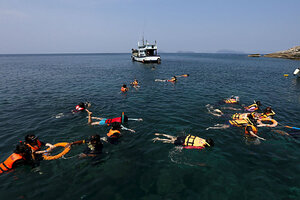Why Thailand is closing a lovely island in the Andaman Sea to tourists
Koh Tachai, one of Thailand's beautiful island destinations, will remained closed to tourists indefinitely, say Thai officials.

Tourists snorkel near Maiton Island in Phuket, Thailand March 18, 2016. With its palm-fringed beaches, Buddhist culture and racy nightlife, Thailand has been the poster child for Asian tourism for decades. But dark clouds could be forming even as a record of 32 million tourists are expected this year.
REUTERS/Athit Perawongmetha
Koh Tachai, a popular Thai island will close indefinitely to tourists this fall due to concerns of damage and deterioration from severe overcrowding.
The island, which has become immensely popular among tourists for its white sand beaches and picturesque coastline, also has extensive system of rare blue coral reefs in the surrounding waters which has become threatened due to heavy presence of restaurants and visiting snorkelers.
The closure of Koh Tachai is emblematic of a nation learning how to balance the value of its natural resources with the economic benefits of tourism.
Koh Tachai, part of the beautiful Mu Koh Similan National Park located in the Andaman Sea, around 45 miles off the coast of south-west Thailand, closes yearly along with the rest of the park during the monsoon season from mid-May to October 15th. However, this year, Thai officials announced on May 10th that the island would not be reopening and will remain closed indefinitely.
“Thanks to its beauty, Koh Tachai has become a popular tourist site for both Thai and foreign tourists. This has resulted in overcrowding and the degradation of natural resources and the environment,” Tunya Netithammakul, the director general of the Department of National Parks, Wildlife and Plants Conservation told the Bangkok Post.
“We have to close it to allow the rehabilitation of the environment both on the island and in the sea without being disturbed by tourism activities before the damage is beyond repair.”
The first quarter of 2016 alone saw over 9 million tourists visit Thailand, with potentially 35 million people total forecasted throughout the course of the year.
According to Assistant Professor Thon Thamrongnawasawat, the deputy dean of the Faculty of Fisheries of Kasetsart University, a single beach on Koh Tachai that should accommodate around 70 people regularly held over 1,000 tourists and was populated with tour boats and food stalls, reported the Bangkok Post.
“It is often said that tourism is a two-edged sword,” Jonathon Tourtellot wrote in an article for National Geographic about tourism in the Galapagos — another popular tropical destination where conflicts developed between locals and tourism practices over the restricted method of allowing visitors to view wildlife.
Authorities in Ecuador had developed excursion schedules and size limitations to avoid disrupting the natural habitat as much as possible, but the locals on the mainland were largely ignored.
“Good ecotourism requires significant benefit to locals, and that wasn’t happening. In the 1990s fishermen rebelled against fishing restrictions, infamously attacking the national park office and killing several giant tortoises to make their point,” wrote Mr. Tourtellot.
The Ecuadorian government — which manages the Galapagos National Park — periodically closes tourist access to the park in specific areas, such as the 2011 closing of the giant tortoise corrals due to littering and lack of respect for governing rules.
The ecotourism issues the governing bodies are dealing with in the Galapagos are universally relevant. The tourism industry brings certain popular locales enormous operating revenue, which also helps fund maintenance and environmental protection programs. As access becomes restricted, that income diminishes, sometimes drastically, and that can then threaten elements of the parks’ survival.
When the United States government shut down for 16 days in 2013, the US National Parks were closed as well. That closure resulted in almost 8 million fewer visitors with an estimated loss of $414 million in visitor spending, which was a heavy blow for both the parks and their surrounding communities.
In Thailand, Mr. Thamrongnawasawat said he had been criticized by the tourism industry for promoting the closure of Koh Tachai, reported The New York Times. He said however, “the problem is that we have damaged our marine resources for a long time. If we want it to recover, we must use strong medicine. I am not proposing to close all islands. But we have to start thinking about the plan to tackle the increasing number of tourists.”
Since the decision to close Koh Tachai to tourists indefinitely was announced, no further information has been provided about plans to reopen the island in the foreseeable future. However, two nearby deep-sea dive sites will remain open with tour guides running the risk of losing their licenses if they take visitors to the island itself.

